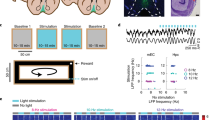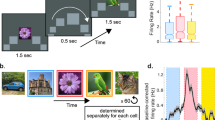Abstract
Theta-phase precession in hippocampal place cells1 is one of the best-studied experimental models of temporal coding in the brain. Theta-phase precession is a change in spike timing in which the place cell fires at progressively earlier phases of the extracellular theta rhythm as the animal crosses the spatially restricted firing field of the neuron1,2,3,4,5. Within individual theta cycles, this phase advance results in a compressed replication of the firing sequence of consecutively activated place cells along the animal’s trajectory2,6,7,8, at a timescale short enough to enable spike-time-dependent plasticity between neurons in different parts of the sequence. The neuronal circuitry required for phase precession has not yet been established. The fact that phase precession can be seen in hippocampal output stuctures such as the prefrontal cortex9 suggests either that efferent structures inherit the precession from the hippocampus or that it is generated locally in those structures. Here we show that phase precession is expressed independently of the hippocampus in spatially modulated grid cells10,11 in layer II of medial entorhinal cortex, one synapse upstream of the hippocampus. Phase precession is apparent in nearly all principal cells in layer II but only sparsely in layer III. The precession in layer II is not blocked by inactivation of the hippocampus, suggesting that the phase advance is generated in the grid cell network. The results point to possible mechanisms for grid formation and raise the possibility that hippocampal phase precession is inherited from entorhinal cortex.
This is a preview of subscription content, access via your institution
Access options
Subscribe to this journal
Receive 51 print issues and online access
$199.00 per year
only $3.90 per issue
Buy this article
- Purchase on Springer Link
- Instant access to full article PDF
Prices may be subject to local taxes which are calculated during checkout




Similar content being viewed by others
References
O’Keefe, J. & Recce, M. L. Phase relationship between hippocampal place units and the EEG theta rhythm. Hippocampus 3, 317–330 (1993)
Skaggs, W. E., McNaughton, B. L., Wilson, M. A. & Barnes, C. A. Theta phase precession in hippocampal neuronal populations and the compression of temporal sequences. Hippocampus 6, 149–172 (1996)
Harris, K. D. et al. Spike train dynamics predicts theta-related phase precession in hippocampal pyramidal cells. Nature 417, 738–741 (2002)
Mehta, M. R., Lee, A. K. & Wilson, M. A. Role of experience and oscillations in transforming a rate code into a temporal code. Nature 417, 741–746 (2002)
Huxter, J., Burgess, N. & O’Keefe, J. Independent rate and temporal coding in hippocampal pyramidal cells. Nature 425, 828–832 (2003)
Tsodyks, M. V., Skaggs, W. E., Sejnowski, T. J. & McNaughton, B. L. Population dynamics and theta rhythm phase precession of hippocampal place cell firing: a spiking neuron model. Hippocampus 6, 271–280 (1996)
Jensen, O. & Lisman, J. E. Hippocampal CA3 region predicts memory sequences: accounting for the phase precession of place cells. Learn. Mem. 3, 279–287 (1996)
Dragoi, G. & Buzsáki, G. Temporal encoding of place sequences by hippocampal cell assemblies. Neuron 50, 145–157 (2006)
Jones, M. W. & Wilson, M. A. Phase precession of medial prefrontal cortical activity relative to the hippocampal theta rhythm. Hippocampus 15, 867–873 (2005)
Fyhn, M., Molden, S., Witter, M. P., Moser, E. I. & Moser, M.-B. Spatial representation in the entorhinal cortex. Science 305, 1258–1264 (2004)
Hafting, T., Fyhn, M., Molden, S., Moser, M.-B. & Moser, E. I. Microstructure of a spatial map in the entorhinal cortex. Nature 436, 801–806 (2005)
O’Keefe, J. & Burgess, N. Dual phase and rate coding in hippocampal place cells: theoretical significance and relationship to entorhinal grid cells. Hippocampus 15, 853–866 (2005)
Burgess, N., Barry, C. & O’Keefe, J. An oscillatory interference model of grid cell firing. Hippocampus 17, 801–812 (2007)
Blair, H. T., Welday, A. C. & Zhang, K. Scale-invariant memory representations emerge from moire interference between grid fields that produce theta oscillations: a computational model. J. Neurosci. 27, 3211–3229 (2007)
Sargolini, F. et al. Conjunctive representation of position, direction and velocity in entorhinal cortex. Science 312, 754–758 (2006)
Yamaguchi, Y., Aota, Y., McNaughton, B. L. & Lipa, P. Bimodality of theta phase precession in hippocampal place cells in freely running rats. J. Neurophysiol. 87, 2629–2642 (2002)
Mehta, M. R., Barnes, C. A. & McNaughton, B. L. Experience-dependent, asymmetric expansion of hippocampal place fields. Proc. Natl Acad. Sci. USA 94, 8918–8921 (1997)
Mehta, M. R., Quirk, M. C. & Wilson, M. A. Experience-dependent asymmetric shape of hippocampal receptive fields. Neuron 25, 707–715 (2000)
Blum, K. I. & Abbott, L. F. A model of spatial map formation in the hippocampus of the rat. Neural Computat. 8, 85–93 (1996)
Mehta, M. R. Neuronal dynamics of predictive coding. Neuroscientist 7, 490–495 (2001)
Ekstrom, A. D., Meltzer, J., McNaughton, B. L. & Barnes, C. A. NMDA receptor antagonism blocks experience-dependent expansion of hippocampal ‘place fields’. Neuron 31, 631–638 (2001)
Zugaro, M. B., Monconduit, L. & Buzsaki, G. Spike phase precession persists after transient intrahippocampal perturbation. Nature Neurosci. 8, 67–71 (2005)
Alonso, A. & Llinas, R. R. Subthreshold Na+-dependent theta-like rhythmicity in stellate cells of entorhinal cortex layer II. Nature 342, 175–177 (1989)
Klink, R. & Alonso, A. Ionic mechanisms for the subthreshold oscillations and differential electroresponsiveness of medial entorhinal cortex layer II neurons. J. Neurophysiol. 70, 144–157 (1993)
Erchova, I., Kreck, G., Heinemann, U. & Herz, A. V. Dynamics of rat entorhinal cortex layer II and III cells: characteristics of membrane potential resonance at rest predict oscillation properties near threshold. J. Physiol. (Lond.) 560, 89–110 (2004)
Schmitz, D., Gloveli, T., Behr, J., Dugladze, T. & Heinemann, U. Subthreshold membrane potential oscillations in neurons of deep layers of the entorhinal cortex. Neuroscience 85, 999–1004 (1998)
Hamam, B. N., Kennedy, T. E., Alonso, A. & Amaral, D. G. Morphological and electrophysiological characteristics of layer V neurons of the rat medial entorhinal cortex. J. Comp. Neurol. 418, 457–472 (2000)
Dickson, C. T., Mena, A. R. & Alonso, A. Electroresponsiveness of medial entorhinal cortex layer III neurons in vitro . Neuroscience 81, 937–950 (1997)
Giocomo, L. M., Zilli, E. A., Fransen, E. & Hasselmo, M. E. Temporal frequency of subthreshold oscillations scales with entorhinal grid cell field spacing. Science 315, 1719–1722 (2007)
Kloosterman, F., Witter, M. P. & Van Haeften, T. Topographical and laminar organization of subicular projections to the parahippocampal region of the rat. J. Comp. Neurol. 455, 156–171 (2003)
Acknowledgements
We thank R. Skjerpeng for programming; M. P. Witter for advice on electrode localization; A. Treves for statistical advice; A. M. Amundsgaard, D. Derdikman, K. Haugen, K. Jenssen, E. Sjulstad and H. Waade for technical or other assistance; and several colleagues for discussion. The work was supported by the Kavli Foundation, a Centre of Excellence grant from the Norwegian Research Council and the 2006 Life Science award of the Fondation Bettencourt Schueller.
Author Contributions T.H., M.F., M.-B.M. and E.I.M. planned the experiments; T.H., M.F., T.B. and M.-B.M. performed the experiments; all authors analysed the data; and E.I.M. wrote the paper. All authors discussed the results and contributed to the manuscript. M.F. and T.H. contributed equally.
Author information
Authors and Affiliations
Corresponding author
Supplementary information
Supplementary Figures 1-8
The file contains Supplementary Figures 1-8 and Legends. Recording locations in layers II and III of MEC, additional examples of phase modulation in layers II and III of MEC and CA3 and CA1 of the hippocampus, simultaneously recorded data from layers II and III, coherence of theta field oscillations between layers II and III of MEC, firing rate as a function of theta phase, and distribution of phase relationships across 20% segments of the firing fields in each recording area. (PDF 8002 kb)
Supplementary Figures 9-13
The file contains Supplementary Figures 9-13 and Legends. Firing phase as a function of time after entering the firing field, layer II fields with positive position-phase regression lines, change in rate of phase precession along the dorsoventral axis of MEC, phase precession in layer V of MEC, and phase relationships of cells in the layer III – layer II transition zone. (PDF 6128 kb)
Supplementary Figures 14-18
The file contains Supplementary Figures 14-18 and Legends. Recording and infusion locations and hippocampal inactivation curves for phase precession experiments with muscimol infusions into the hippocampus, group data and individual examples showing asymmetry and experience-dependent shifts in firing locations of grid cells and place cells, and examples and analyses showing lack of relation between phase precession and experience-dependent changes in field shape or field size in grid cells. (PDF 3279 kb)
Supplementary Methods
The file contains Supplementary Methods. (PDF 214 kb)
Rights and permissions
About this article
Cite this article
Hafting, T., Fyhn, M., Bonnevie, T. et al. Hippocampus-independent phase precession in entorhinal grid cells. Nature 453, 1248–1252 (2008). https://doi.org/10.1038/nature06957
Received:
Accepted:
Published:
Issue Date:
DOI: https://doi.org/10.1038/nature06957
This article is cited by
-
Induced neural phase precession through exogenous electric fields
Nature Communications (2024)
-
Theta mediated dynamics of human hippocampal-neocortical learning systems in memory formation and retrieval
Nature Communications (2023)
-
Phase information is conserved in sparse, synchronous population-rate-codes via phase-to-rate recoding
Nature Communications (2023)
-
Homogeneous inhibition is optimal for the phase precession of place cells in the CA1 field
Journal of Computational Neuroscience (2023)
-
Functional neuronal circuitry and oscillatory dynamics in human brain organoids
Nature Communications (2022)
Comments
By submitting a comment you agree to abide by our Terms and Community Guidelines. If you find something abusive or that does not comply with our terms or guidelines please flag it as inappropriate.



